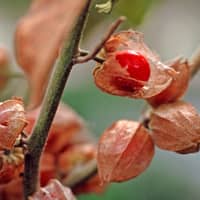Ashwagandha (Withania somnifera) is a plant in the Solanaceae or nightshade family.
Also known as Indian ginseng, poison gooseberry, or winter cherry,
Composition
The green berries contain amino acids, a proteolytic enzyme, condensed tannins, and flavonoids. They contain a high proportion of free amino acids which include proline, valine, tyrosine, alanine, glycine, hydroxyproline, aspartic acid, glutamic acid, cystine and cysteine. The presence of a proteolytic enzyme, chamase, in the berries may be responsible for the high content of the amino acid.[1]
Healing Properties
Adaptogen
Antiinflammatory
Antimicrobial
The antibiotic activity of the roots as well as leaves has recently been shown experimentally.[1:1]
Antibiotic (Antibacterial)
Withania somnifera in concentration of 10g/ml inhibited the growth of various Gram-positive bacteria, acid-fast and aerobic bacilli, and pathogenic fungi.[1:2]
- It was active against Micrococcus pyogenes var aureus and partially inhibited the activity of Bacillus subtilis glucose-6-phosphatedehydrogenase.[1:3]
Antifungal
Withania somnifera in concentration of 10g/ml inhibited the growth of various pathogenic fungi.[1:4]
Antioxidant
Anxiolytic
Aphrodisiac
Cardioprotective
(Heart Health)
Immunomodulator
Longevity
Reproductive Health
Disease / Symptom Treatment
Anxiety
Arthritis
Asthma
Diabetes
Insulin Resistance
Fatigue
Emaciation
Fibromyalgia
Hypothyroid
Insomnia
Low Libido
Title: Pharmacological and Phytomedicine Assessment of Withania Somnifera
Publication: Indian Journal of Applied Research
Date: Feb 2019
Study Type: Chemical Analysis
Author(s): Namrata Dwivedi, Kalpana Trivedi, I. P. Tripathi
Institution(s): Faculty of Science & Environment, MGCGV, Chitrakoot, Satna, M.P.
Copy: archive, archive-mirror ↩︎ ↩︎ ↩︎ ↩︎ ↩︎
